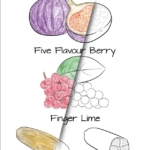Fruits and Vegetables for G
Ginger, garlic, and Guava drawn in simple shapes ready for coloring. These drawings are designed to engage the curious minds of toddlers and preschoolers, spark their creativity, and hopefully healthy eating.
And as always, free to download.
Did you know?
Positive Effect on Health: Ginger is not just a spice; it’s a natural remedy with a host of health benefits. It’s well-known for its potential to alleviate nausea, making it a popular choice for motion sickness and morning sickness relief. Ginger also possesses anti-inflammatory and antioxidant properties, which may support various aspects of health. Whether you use it in teas, stir-fries, or baked goods, incorporating ginger into your diet not only enhances the flavor of your dishes but also offers potential wellness advantages. So, when you savor the spicy allure of ginger, you’re not just enjoying a flavorful ingredient; you’re also tapping into the power of a root that has been celebrated for its taste and health benefits for generations! 🌱😋🍛
Interesting Fact: Ginger, with its aromatic and spicy flavor, is a root that has been treasured for its culinary and medicinal properties for centuries. It has a knobby appearance with pale yellow or tan skin and a fiery, zesty taste that adds depth and warmth to a wide range of dishes and beverages. Ginger’s versatility makes it a staple in cuisines around the world.
Geographical Origin: Ginger is believed to have originated in Southeast Asia, specifically in the lush tropical regions of India and China. It has a storied history, having been traded along ancient spice routes and used in traditional medicine and culinary practices across continents.
Positive Effect on Health: Beyond its culinary prowess, garlic boasts an impressive array of potential health benefits. It contains allicin, a compound known for its antibacterial and antiviral properties, which may support immune health. Garlic has also been associated with cardiovascular benefits, including the potential to lower blood pressure and improve cholesterol levels. Additionally, it’s a source of various vitamins and minerals, such as vitamin C and manganese.
Whether you roast it to mellow its flavor, sauté it to release its aroma, or use it as a base for sauces and soups, garlic not only elevates your dishes but also offers potential health advantages. So, when you embrace the robust allure of garlic, you’re not just enhancing the taste of your cuisine; you’re also experiencing the culinary and potential wellness magic of this ancient herb! 🌿😋🍝
Interesting Fact: Garlic, with its pungent aroma and bold flavor, is a culinary superstar that has been enchanting taste buds for millennia. This bulbous herb, known for its distinctive cloves, packs a punch in the kitchen. It’s a fundamental ingredient in countless savory dishes and adds depth and complexity to cuisines from around the world.
Geographical Origin: Garlic’s origins are believed to be traced back to Central Asia, in the region that encompasses modern-day Kazakhstan and Uzbekistan. Over time, it spread to various corners of the globe, becoming an integral part of diverse culinary traditions. From Mediterranean cuisines to Asian stir-fries, garlic’s presence is undeniable.
Positive Effect on Health: Guava not only tantalizes your taste buds but also offers a bounty of health benefits. It’s a nutritional powerhouse, packed with vitamin C, which supports immune function and skin health. Guava is also rich in dietary fiber, which aids digestion and helps maintain a feeling of fullness. Additionally, it provides essential vitamins like vitamin A and B-complex vitamins, along with minerals such as potassium and magnesium.
Whether you bite into ripe guava, sip on guava juice, or enjoy it in various culinary creations, you’re not just indulging in a tropical delicacy; you’re also embracing a fruit that nourishes your body and transports your senses to the sunny shores of the tropics! 🌴🍈😋
Interesting Fact: Guava, with its tropical charm and sweet, fragrant flavor, is a fruit that transports your taste buds to sun-kissed orchards and lush landscapes. This pear-shaped fruit, often with pale green to pinkish flesh, is a delightful combination of sweetness and tartness. Whether enjoyed fresh, as a juice, or in jams and desserts, guava’s unique taste is a tropical delight.
Geographical Origin: Guava is believed to have originated in Central America and southern Mexico, where it has been cultivated for thousands of years. It has since spread to tropical and subtropical regions around the world, making it a beloved fruit in countries with warm climates.







